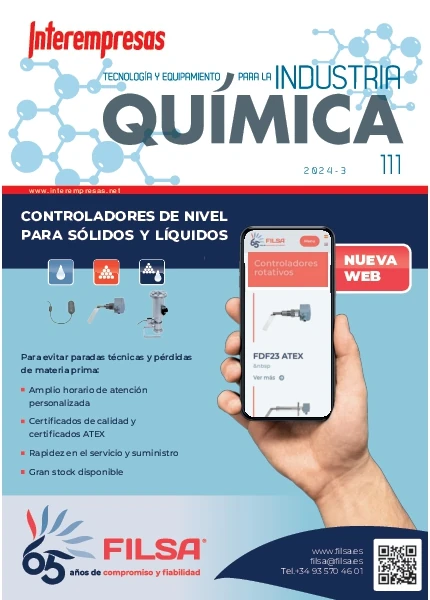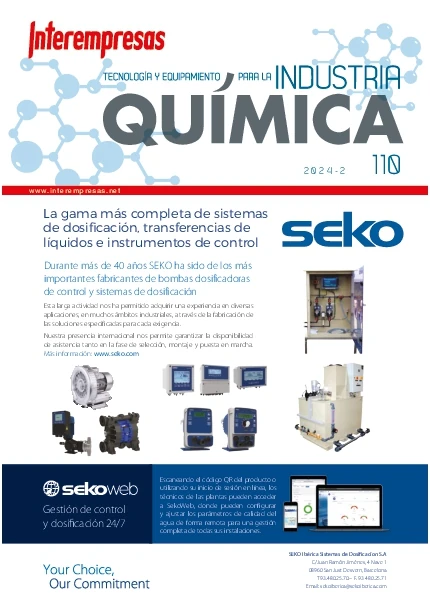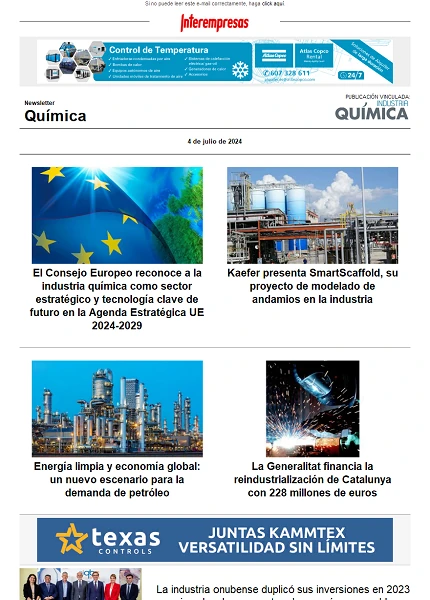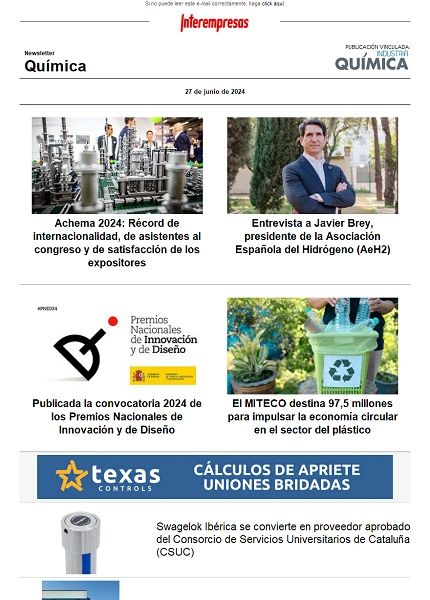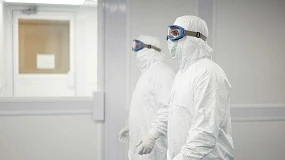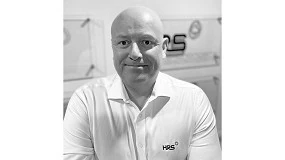Quick selection of a fuel transfer adjusted to the mould
An important factor in the production of a piece of plastic injected is the suitability of the machine where is going to inject this mold. The selection must be made at an early stage that is considered the construction of a new mold.
To select the injection machine suitable for a particular mold is necessary to check many factors of a technical nature. A usual technique is to look at only the force of closure, and in any case the injection volume and dimensions of the mould. This can cause problems of injection that are not attributed to the machine.
In some cases it could have serious economic and technical problems either by the need of having to buy a new machine or for expenses incurred after injection during the duration of the project in order to obtain a valid piece for sale. This would involve a cost to the company unexpected and probably unacceptable, when considering the feasibility of injecting a piece of plastic.
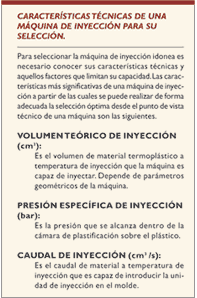
The size of the machine
Because of the necessity of generating greater forces closing, to inject into molds which require it, it is inevitable to increase the size of the system and therefore of the machine in general. On the other hand a large machine can also be endowed of a greater unity of injection capable of inject and laminating greater amount of material.
How the program works
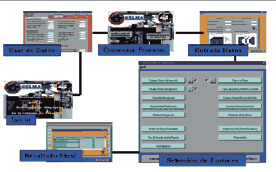
(a) data entry: the first part is a form that allows us to introduce nearly all of the necessary data for subsequent calculations.
(b) selection process: then you can access a new form where appear the factors against which conduct the selection process. By clicking on each one of them to access a new screen where we are called the conformity on already entered data on that factor or that we do now for the first time.
This gives us a first selection from a single factor and allows you to change values related to him if this was required by the user, and can return to again make this partial selection.
Finally, from the screen where all the factors are marked those with whom you want to make the final selection.
Final presentation of results: appears a form with the outcome of the selection where we can also see new parameters of the machines, order them to our own liking, deleting those that we want, direct access to the file of the machine or save results to a text file.
DATABASE
The database has information on the different machines. This database can be expanded or modified easily. The information associated with each machine is reflected in the following figure:

The data corresponding to the characteristics of the mold are introduced through the following screens:

Selection of factors
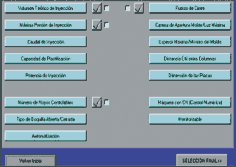
EXAMPLE OF APPLICATION OF FACTORS
Theoretical volume of injection
When this factor is selected the screen through which the program calculates the theoretical volume of the selected material, at the temperature of injection, injection mold.
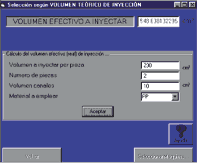
• If the theoretical volume of injection of the machine is less than necessary, the machine is excluded because it is not able to inject parts of that size.
• If they are close, restricted its use, since the amount of material may be inadequate in parts that require precision.
• If the (V). theoretical machine is far higher than necessary, the dose to inject is too small it although it is possible to use is not recommended, as that can cause the degradation of the material that should go (long in proportion) plasticizing cylinder before being injected.
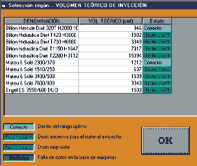
Clamping force
If you do not know its exact value approximations it from; material to inject, thickness of piece and projected average area.
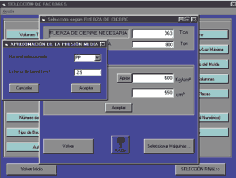
• Those machines whose clamping force does not exceed the necessary are excluded by not keep closed the template correctly.
• It is recommended to exclude those machines whose clamping force is much higher than the necessary to the be therefore using a machine oversize for the necessary characteristics which can also damage the mold.
Pressure specified in injection.
If you do not know its exact value approximations it from; material to inject, thickness of piece, filling time and length of flow.
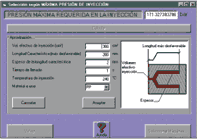
• Are excluded those machines are not able to produce the necessary pressure, as this implies does not perform the correct filling of the mold.
Theoretical flow of injection
Selection process
• Those machines whose flow-injection rate is below the minimum flow are excluded for not being able to inject the material at the time.
• Machines whose flow-injection rate is greater than the minimum are suitable for injection but only those that are above the optimal flow will do so properly.
Flow of plasticizing
For optimal development of the process, the machine must have sufficient plasticizing capacity to carry out the phase of dosing (preparing to injection dose) during the time of cooling of the piece.
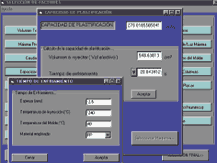
Selection process
• Is not an exclusionary factor, if a machine is not able to prepare the fast enough material there will be a delay, with the consequent economic cost, but does carry the correct injection of the piece.
Power of injection
We can find in the situation of not being able to inject a mold or end of fill it under the desired conditions without having reached the maximum values of pressure and flow of our machine, by the fact that the power required (power = flow x pressure) is greater than the available.
Selection process
• Not an exclusionary factor to be able to increase the power of the machine through the use of a more powerful bomb or thanks to a battery that provides great amount of oil for a short time, allowing you to reach the power maximum more rapidly than with a bomb.
Maximum opening/light race
This distance has to be enough to allow for the expulsion of the piece and its subsequent manipulation, by an operator or an articulated arm. Considered that it must be greater than 2.5 times the depth of the piece, which is the width of the projection of the piece on a plane perpendicular to the partition of the mold.(Distance between the two sides further away from the piece measures on the perpendicular to the plane of partition).

• In machines with mechanical lock (knee) system use the career of maximum aperture which indicates the position that the system of links is fully reflected. Excluding the machines whose career of opening does not exceed 2.5 times the depth of the piece.
• In machines with hydraulic locking system where the mobile plate does not have the above limitation and can scroll to the part end of the machine, use the luza maximum, excluding those machines whose maximum light is not greater than the sum of the thickness of the mold over 2.5 times the depth of the piece.
Maximum/minimum thickness of mold
Selection process
• Are excluded those machines whose maximum thickness is less than our mold. This factor is only applicable to machines with mechanical closure to have limited the maximum size of mold by need have extended their articulated links to realize the clamping force.
• The minimum thickness is not a factor precluding there is always the possibility of placing a few residual dishes that allow us to reach this minimum size.
Distance between columns useful
Selection process
• The useful distance between columns must be such as to enable the mounting of the mold without interfering with the plates or other elements type time that can stand out from him to the be mounted machine either from the top or side.
Type of nozzle open/closed
Working with certain materials such as PA, PVC and POM, because gases generated at the temperature of injection is necessary open nozzle to allow their escape.
Selection process
• The choice of an open nozzle is not exclusive as nozzles locking system can remain open.
• If you choose closed nozzle, excluding those machines that only have open nozzles.
Automation
Some machines are you can attach a jointed-arm robots or other industrial robot, which is responsible for handling the piece once this has been ejected from the mold. In this way is automates the production, although it is not always advisable or necessary, either the machine is not endowed with this element.
Selection process
• It is an exclusionary factor, if so determined by the user. Automation reduces production times.
Machine with numerical control
Selection process
• Is an exclusionary factor or to be determined by the user, which is a great advantage over the conventional machines for allowing to optimize the process bringing it to our mold needs.
Monitorizable
The current machines are equipped with various entries where probes are connected to collect information on the injection process, such as pressure and temperature values.
Monitorizables are those machines that have the software necessary to show the operator of the machine the graphics and data collected by the probes.
Selection process
• Those not monitorizables machines have the possibility of using an external computer to perform these functions, so this process is not exclusive.
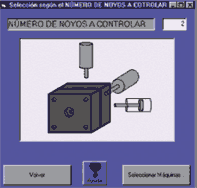
Selection process
• If a machine is not able to control the number of required cores, there is the possibility of using a hydraulic switchboard to control them by what this factor does not exclude the use of any machine.
Once made the selection of independently for each of the desired factors, mark the screen selection of factors those which we involve in the final selection process.
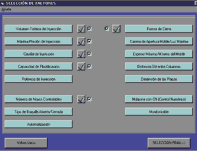

SEE DETAILS OF THE MACHINE
By "double-clicking" on the machine you want (on the row), and after giving our agreement will open the window where the file of the machine
Finally we save the result, obtaining the following file:


